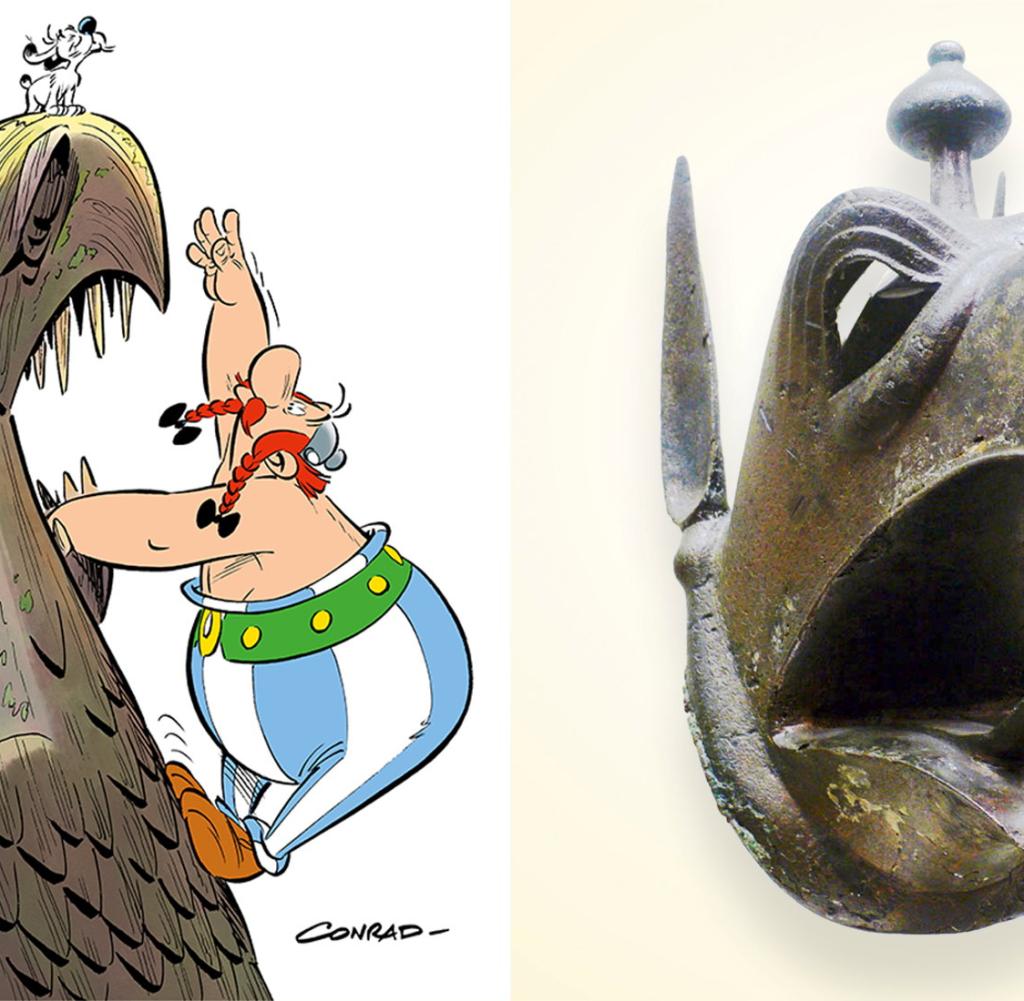MI had always suspected that Troubadix wasn’t a bad bard, and his voice wasn’t that terrible. Rather, he simply overwhelms the provincial Gauls in his village with his modernity. Already in “Asterix and the Normans” the young Grautvornix from Lutetia came to the cultural wasteland of Aremorica and prophesied to the bard that the people in the metropolis would become “Olympix” (a reference to the Olympia concert hall in Paris, which was very important in the 1960s). completely freak out when they hear his music.
Now in the very latest Asterix volume “The White Iris” we get it confirmed: Troubadix is a misunderstood punk. At a concert that he is allowed to give this time for the villagers, he sings a song in the German translation called “Claudius has a shepherd dog”. This is of course an allusion to “Claudia has a German Shepherd”, a piece about a zoophile young woman from the completely incorrect early days of the doctors, which was on the index for a long time and which the band no longer plays todaybecause it is sexist, contemptuous of species and insensitive to people with erotic preferences that deviate from the mainstream.
The big surprise is that Troubadix’s audience reacts to the song and the rest of his performance in a friendly and even enthusiastic manner. This can only be explained by an intellectual fashion trend that has suddenly turned the wild, rowdy Gauls into culturally sensitive, positive-thinking, quasi-modern people who are open to every innovation, no matter how strange. That sounds good, but it endangers the village’s ability to resist Roman imperialism.
The originator of this change is Visusversus, a Roman. The “chief medicus” of Julius Caesar’s armies is a propagandist of a holistic and mindful way of thinking that focuses on “mental health”. He is once again one of those non-military specialists that Caesar regularly sends to use their methods to undermine the Gauls’ morale and prepare for their assimilation. His predecessors were the architect Quadratus in “Asterix and the Satellite City”, the schemer Tullius Destructivus in “Dispute over Asterix” and the young economist Technokratus, who wanted to make the Gauls decadent with money in “Obelix GmbH & Co. KG”.
The indigenous Gallic shaman in The Seer is also a predecessor of Visusversus. With their messages, both obviously address psychological needs that even lie dormant in the psyche of the rough Gauls – especially women who are neglected in male society. As in “The Seer”, this time it is Gutemine, the wife of the village chief Majestix, who proves to be particularly receptive to the stranger’s message.
Visusversus’ method is a mixture of many trend elements of alternative thinking of the past decades: New Age, coaching, positive thinking, neuro-linguistic programming and conscious nutrition (instead of wild boar he recommends fresh regional fish – veganism cannot be expected of the Gauls, even in comics). He brings the whole thing to people with flowery, semi-poetic sayings and wisdom of life, as we know them from inspirational Facebook tiles that have sunsets on the beach as the background. The kind of stuff that only people share that you either immediately unfriend. Or at least muted because you don’t want to hurt them. Because you suddenly realize that the beautiful girl from high school 30 years ago has become a weak-minded esoteric whose psychological stability you don’t want to endanger.
Majestix and Gutemine are experiencing a crisis
Source: Asterix® – Obelix® – Idefix® / © 2023 Hachette Livre/ Goscinny – Uderzo
With his whispering, Visusversus lures Gutemine away from her husband to Lutetia, where she and Asterix, Obelix and Majetix, who follow her, are confronted with further phenomena of Gallic modernity: an express train called a “thalix” consisting of coupled carts. With the “new” cuisine, in which the wild boar is served in tiny portions. With an acting star who goes by the beautiful name Boxofix. With two-wheeled cart scooters that you can rent and which Obelix uses to shut himself up several times. And metropolitan intellectuals who rave to Gutemine about how great the simple life in the country is.
In the end everything breaks up with a big mass brawl in a theater. This was also something similar in “Asterix and the Copper Cauldron”. The new author Fabcaro puts a lot of effort into ensnaring the classic readership with such recognition moments. At the same time, however, he manages to create significantly more gags than the copywriter Jean-Yves Ferri, who was clearly tired in the last volumes and who, together with the illustrator Didier Conrad, replaced the original illustrator Albert Uderzo (1927-2020) ten years ago. René Goscinny, who co-invented and decisively shaped the character Asterix as a lyricist and scenarist, had already died in 1977.
“The White Iris” is now significantly better than “Asterix and the Griffin” or “The Daughter of Vercingetorix”, the last volumes with Ferri as the copywriter. But there is one thing it is not: a reckoning with the woke spirit of the times. There had been rumors about that. But even if there are certain overlaps between the teachings of the Roman guru Visusversus and the woke ideology, there is still a serious difference: the cult of the white iris (a spiritual symbol like the blue flower of Romanticism) makes people tolerant and relaxed they react calmly and openly to encounters with completely different people and challenging experiences. Nobody needs a safe space here because everyone is safe within themselves.
The tragic irony is that this endangers the safe place that the Gauls really need – namely their village, protected by the power of the magic potion. And so the teaching of the white iris is also a parable for other actually sympathetic worldviews – total pacifism, total tolerance, total grassroots democracy – which don’t always work in reality.
Fabcaro (text), Didier Conrad: “The white iris“, Egmont, 7.99 euros



